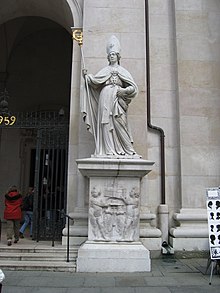Virgil of Salzburg

Virgil von Salzburg (* around 700 in Ireland ; † November 27, 784 in Salzburg ) was a universally important scholar of the early Middle Ages, holy bishop of the diocese of Salzburg and abbot of the monastery of St. Peter .
ancestry
Virgil came from an Irish noble family, was called Feirgil of Aghaboe and received his education at Iona Monastery . Perhaps he came from the royal family of Loegaire. It is disputed whether he entered the Aghaboe monastery in what is now County Laois (Ireland) and is identical with the local abbot Feirgil .
With two companions he went as a missionary to the Franconian houseman Pippin III in 743 . who sent him in 745 to Duke Odilo in the Bavarians .
Act as a bishop
When he arrived in Salzburg, Virgil could not yet control the diocese because he had not yet received his episcopal ordination. For such tasks he had brought Bishop Dobdagrecus with him to Bavaria from his Irish homeland, who was to lead the diocese for two years. Dobdagrecus took over the spiritual direction of the male monastery Chiemsee after Virgil was appointed bishop .
It was not until June 15, 749 (or 755) that Virgil, who was already active in the diocese of Salzburg, was ordained a bishop. In the same year he became abbot of the St. Peter monastery.
Because of a Latin baptismal formula, which a less educated priest had somewhat distorted, a dispute arose with Boniface . Because Virgil also represented the antipodal doctrine , he was suspected of heresy . In these cases the Pope did not really decide in Virgil's favor, but the questions were quickly forgotten due to the Pope's death.
Before 767, Virgil sent Modestus and Libellus to missionary work in Carantania , which is why he is also called the Apostle of Carantania and Carinthia. At the same time the diocesan area was enlarged. In this context, three mission centers were particularly important: Maria Saal , Sankt Peter in Holz and St. Johann bei Knittelfeld.
Virgil had the first cathedral built in Salzburg, which he consecrated on September 24, 774 (or 784) to St. Rupert of Salzburg , whose bones he had transferred to Salzburg. After almost forty years in the episcopate, Virgil died on November 27, 784 in Salzburg, he was buried in the cathedral there.
He was canonized on June 18, 1233 . In 1288 an altar was erected for him in Salzburg Cathedral , where he has been buried ever since.
Polymath
Virgil was an eminent scholar, especially his knowledge of theology, philosophy, historiography, astronomy, and mathematics. Because of his geographical knowledge, he was nicknamed geometer .
Salzburg owed its first cultural heyday since the fall of the Roman Empire to the work of St. Virgil. Virgil promoted handicrafts through commissions. The famous book of brotherhoods by Saint Peter and the biography of Saint Corbinian also go back to his suggestion . Virgil wrote various writings, especially the pamphlet Libellus Virgilii and probably the original version of the biography of St. Rupert ( Vita Ruperti ).
Remembrance Day and Adoration
According to the Roman Catholic regional calendar for the German-speaking area , he is celebrated together with St. Rupert on September 24th ; in the rest of the Roman Catholic Church and in the Evangelical Calendar of Names , his feast day is on November 27th .
Patronage: Virgilius-von-Salzburg-Kirche
The peasant rule that applies to the day of the saint's remembrance is: If it freezes on Virgilius, in March it must be cold.
iconography
He is portrayed as a bishop with a double-towered Romanesque cathedral and called to help with childbirth.
literature
- Heinrich Dopsch , Roswitha Juffinger (ed.): Virgil von Salzburg, missionary and scholar . Contributions to the international symposium from 21.-24. September 1984 in the Salzburg Residence. Salzburg State Government, Salzburg 1985.
- Heinz Dopsch : Virgil (ius) of Salzburg . In: Bruno Steimer (ed.): Lexicon of saints and veneration of saints . 3. Persons Part: R-Z . Herder, Freiburg (Breisgau) 2003, ISBN 3-451-28193-7 .
- Thomas Forstner: Saint Virgil . In: Peter Pfister (ed.): Your friends of God all too equal. Saints and Blessed in the Archdiocese of Munich and Freising . Archbishop Friedrich Cardinal Wetter on his 75th birthday. Don Bosco-Verlag, Munich 2003, ISBN 3-7698-1405-3 .
- Heinz Löwe : A literary opponent of Boniface. Virgil von Salzburg and the cosmography of Aethicus Ister (= treatises of the Academy of Sciences and Literature. Humanities and social science class. Born 1951, Volume 11). Steiner, Wiesbaden 1952.
- Franz Pagitz: Virgil as the builder of the Salzburg Dome . In: Communications from the Society for Regional Studies in Salzburg . 109, 1969, ISSN 0435-8279 , pp. 15-40.
- Wolfgang Winhard: VIRGIL (IUS) from Salzburg. In: Biographisch-Bibliographisches Kirchenlexikon (BBKL). Volume 12, Bautz, Herzberg 1997, ISBN 3-88309-068-9 , Sp. 1441-1442.
Web links
- Holy Virgil erzbistum-muenchen.de
Individual evidence
- ↑ Joachim Jahn : Ducatus Baiuvariorum: The Bavarian Duchy of the Agilolfinger , p. 143. (= monographs on the history of the Middle Ages). Hiersemann, Stuttgart 1991. ISBN 3-7772-9108-0 .
| predecessor | Office | successor |
|---|---|---|
| John I. |
Bishop of Salzburg 746–784 |
Arn |
| personal data | |
|---|---|
| SURNAME | Virgil of Salzburg |
| ALTERNATIVE NAMES | Virgilius of Salzburg; Feirgil; Fergil |
| BRIEF DESCRIPTION | holy bishop of Salzburg |
| DATE OF BIRTH | around 700 |
| PLACE OF BIRTH | Ireland |
| DATE OF DEATH | November 27, 784 |
| Place of death | Salzburg |
